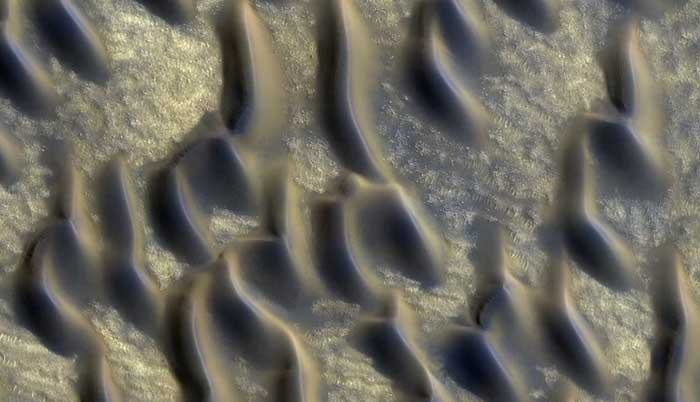![]() Home > Space & Science
Home > Space & Science
What Is Mars Made Of? | Composition Of Planet Mars

Dusty, glass-rich sand dunes like these found just south of the north polar ice cap could cover much of Mars. (False color image) Credit: NASA/JPL/University of Arizona
![]() December 12th, 2017 | 10:26 AM |
December 12th, 2017 | 10:26 AM | ![]() 1871 views
1871 views
SPACE.COM
Mars is the "Red Planet" for a very good reason: its surface is made of a thick layer of oxidized iron dust and rocks of the same color. Maybe another name for Mars could be "Rusty." But the ruddy surface does not tell the whole story of the composition of this world.
Dusty crust
The dust that covers the surface of Mars is fine like talcum powder. Beneath the layer of dust, the Martian crust consists mostly of volcanic basalt rock. The soil of Mars also holds nutrients such as sodium, potassium, chloride and magnesium. The crust is about 30 miles (50 kilometers) thick.
Mars' crust is thought to be one piece. Unlike Earth, the red planet has no tectonic plates that ride on the mantle to reshape the terrain. Since there is little to no movement in the crust, molten rock flowed to the surface at the same point for successive eruptions, building up into the huge volcanoes that dot the Martian surface.
That doesn't mean the crust sits quietly. New research has found that powerful landslides may speed down Martian slopes at up to 450 mph (725 km/h).
"The calculated velocity of landslides (often well in excess of 100 m/s and up to 200 m/s at peak) compares well with velocity estimates based on the run-up of the landslides on mounds," researchers wrote in a study published in The European Physical Journal Plus.
"We conclude that ice may have been an important medium of lubrication of landslides on Mars, even in equatorial areas like Valles Marineris" (the Grand Canyon of Mars).
Any life that ever existed on Mars would have had to cope with the radiation, perhaps by thriving underground. While astronomers continue to search for past or present signs of biology on Mars, no convincing evidence has yet been found.
Mantle and core
Evidence suggests there have been no volcanic eruptions for millions of years, however. The mantle that lies beneath the crust is largely dormant. It is made up primarily of silicon, oxygen, iron, and magnesium and probably has the consistency of soft rocky paste. It is probably about 900 to 1,200 miles (5,400 to 7,200 kilometers) thick, scientists say.
The center of Mars likely has a solid core composed of iron, nickel and sulfur. It is estimated to be between 1,800 and 2,400 miles (3,000 and 4,000 kilometers) in diameter. The core does not move, and therefore Mars lacks a planet-wide magnetic field. Instead, it has sporadic field lines that scientists have nicknamed "Christmas Lights." Without a global magnetic field, radiation bombards the planet making it relatively inhospitable compared to Earth.
Water and atmosphere
Mars is too cold for liquid water to exist for any length of time, but features on the surface suggest that water once flowed on Mars. Today, water exists in the form of ice in the soil, and in sheets of ice in the polar ice caps. The average temperature is about minus 80 degrees Fahrenheit (minus 60 degrees Celsius), although they can vary from minus 195 degrees F (minus 125 degrees C) near the poles during the winter to as much as 70 degrees F (20 degrees C) at midday near the equator.
The atmosphere of Mars is too thin to easily support life as we know it. It is about 95 percent carbon dioxide. The extremely thin air on Mars can also become very dusty. Dust from the planet's surface is routinely kicked up into the atmosphere by giant dust devils— not unlike tornadoes on Earth. At times, the red planet can be partly or wholly consumed by dust storms.
At times, it even snows on Mars. The Martian snowflakes, made of carbon dioxide rather than water, are thought to be about the size of red blood cells. Flakes in the north measure between 8 to 22 microns and those in the south are just 4 to 13 microns.
Although the surface of Mars today is inhospitable for life as we know it, planetary scientists are finding signs that suggest the world may have been hospitable in the past. For instance, NASA's Curiosity rover discovered the element boron, which plays a role in stabilizing sugars needed to make RNA, a key for life.
"Because borates may play an important role in making RNA — one of the building blocks of life — finding boron on Mars further opens the possibility that life could have once arisen on the planet," Patrick Gasda, a postdoctoral researcher at Los Alamos National Laboratory in Los Alamos, New Mexico and lead author of the study, said in a statement.
"Essentially, this tells us that the conditions from which life could have potentially grown may have existed on ancient Mars, independent from Earth."
Source:
courtesy of SPACE
by Tim Sharp
If you have any stories or news that you would like to share with the global online community, please feel free to share it with us by contacting us directly at [email protected]